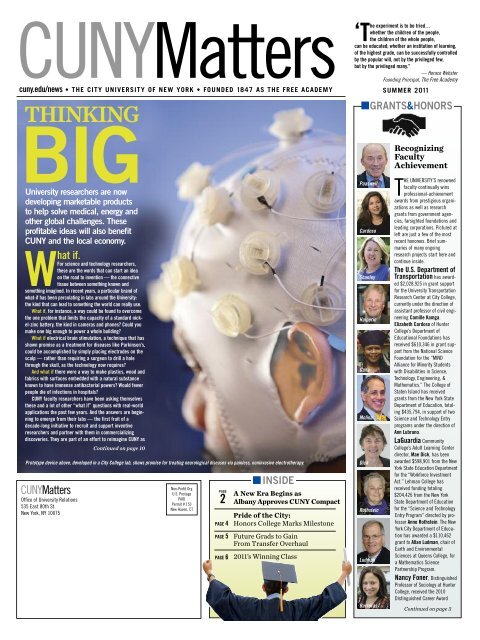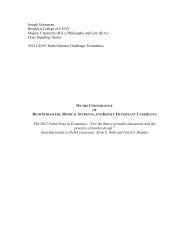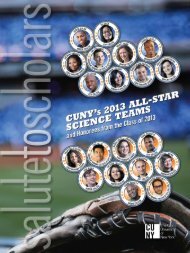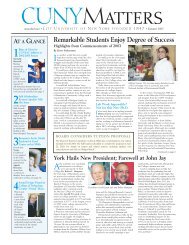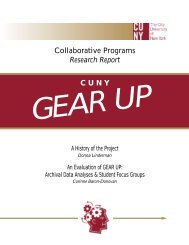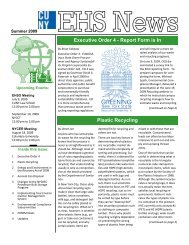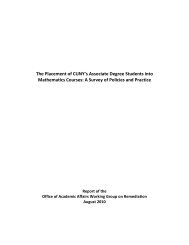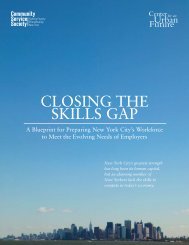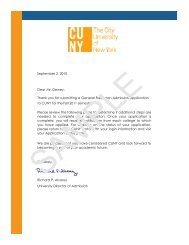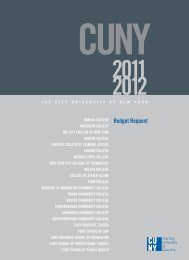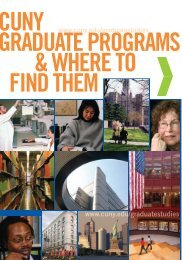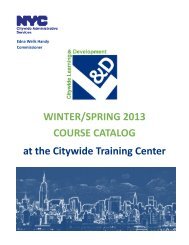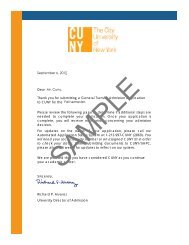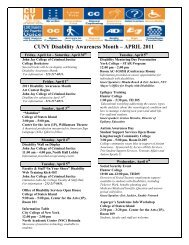THINKING - CUNY
THINKING - CUNY
THINKING - CUNY
- No tags were found...
You also want an ePaper? Increase the reach of your titles
YUMPU automatically turns print PDFs into web optimized ePapers that Google loves.
SalutingaPlaceofHonorIn its first decade,Macaulay Honors Collegeat <strong>CUNY</strong> has made aunique contribution to theUniversity’s mission toattract outstandingstudents.Chancellor Goldstein and philanthropist William E.Macaulay preside at Honors College graduation.AT ITS FIRST commencement as adegree-granting institution,Macaulay Honors College at<strong>CUNY</strong> marked the 10th anniversaryof an idea that has burnished the imageof the University.The 300 members of the 2011 graduatingclass earned degrees in 64 fields, with manystudents having double or triple majors. Athird graduated summa cum laude. Fiftyonewere elected to the Phi Beta Kappanational honor society. Six delivered graduationspeeches at their home colleges. Andamong them were recipients of Rhodes,Coro, Fulbright, Gilman, Goldwater,Merage, Salk, Truman and WatsonFellowships or Scholarships.More than 1,000 alumni are out in theworld as teachers, doctors, lawyers, scientists,entrepreneurs and more, “definingsuccess in 1,000 different ways,” as DeanAnn Kirschner put it.Starting this year, Macaulay studentswill receive a joint diploma bearing thenames of both Macaulay Honors Collegeand their home college. The stategreenlighted degree-granting authority,which the Board of Trustees had sought tospotlight Macaulay’s unique contribution tostudents’ education; to foster a strongersense of community among students; and tofurther showcase Macaulay’s ongoing successin attracting, supporting and retainingoutstanding students.At the commencement at Alice TullyHall in June, former New York City SchoolsChancellor Joel Klein, who receivedMacaulay’s first honorary doctorate,recalled the reasons behind the institution’sfounding while lauding the man who conceivedit, <strong>CUNY</strong> Chancellor MatthewGoldstein.“There was a time, before Matt camehere [as chancellor in September 1999],A Surprise Tribute to William E. MacaulayIN A SURPRISE tribute, the graduates of the honors college that bears his name inductedWilliam E. Macaulay, a 1966 honors graduate of City College, into their class at theirgraduation ceremony.“Mr. Macaulay has said that if it were not for <strong>CUNY</strong>, he would not have been able toattend college,” said 2006 Macaulay Honors College at City College graduate DeborahMarch, a doctoral student in African-American and American studies at Yale. “Of course,this is a familiar story for us, for if it were not for Mr. Macaulay, so many of us would not behere today, debt-free and ready to move on with our lives.”Summoning him to the lectern, she added, “The Class of 2011 has a reputation for wantingto make an impact on the world, and so, who better to join their ranks than you, Mr. Macaulay, whosecommitment to this institution will be a testament to your vision and your character for generations.”She presented him with a replica of the medallion that adorns the college’s new ceremonial mace,which was a gift this year from Baruch alumna Lyn Rosensweig and Hunter alumnus Bruce Schnelwar inhonor of her mother, Fern Rosensweig.“This is a surprise and an honor,” said a grinning Macaulay. “This is way better than what I got whenI originally graduated. On my diploma they actually spelled my name wrong. This is a big improvement –they got my name right! I’m very pleased to be a member of your class. Thank you!”when City University had lost the lusterthat it had when I grew up and went to publicschool here in New York City,” Klein toldthe graduates and their families andfriends. “For far too long, City Universitydepreciated the value of education and substituteda false equality for an excellencedriveninstitution. This man, a little morethan a decade later, has transformed thisuniversity. It’s not only a measure of hisleadership, it’s a measure of his values. Andat the center of that transformational effortwas the notion that excellence and equalitycould reside together, but that it had to bebased on excellence.“Macaulay Honors College, both literallyand symbolically, became the flagshipin this array of educationalinstitutions. It sent a powerfulsignal. Now, a little over adecade later, everyone willtalk about what <strong>CUNY</strong>has accomplished. Butit accomplished thatbecause of the leadershipof a great man,”Klein said.For his part,Goldstein honoredphilanthropistandventure capitalistWilliamE. Macaulay(City College,1966) and his wife,ornithologist LindaMacaulay. “None of thiswould be happening at<strong>CUNY</strong> today were it not fortheir largesse, their visionand their commitment tothis extraordinary institution,”he said.Chancellor Goldsteinconceived of an honors college as a way ofattracting gifted students who were choosingelite private schools over <strong>CUNY</strong> and toadd luster to a university that, as Kleindescribed, fairly or not had fallen in publicesteem.This program for select students attendingBaruch, Brooklyn, City, Hunter,Lehman and Queens Colleges and theCollege of Staten Island began in 2001;John Jay College of Criminal Justice hasplans to join the group next year. It offersfree tuition; special academic programs,including four core seminars related toNew York City, and entrée to the city’s culturalinstitutions; $7,500 academic spendingaccounts usable for internationallearning; and laptop computers, among otherperks.In 2006, William Macaulay donated $30million to buy and transform a 1904Manhattan townhouse into a home for theHonors College, as well as to defray tuitionand other costs. He and his wife have beendeeply involved in its programs and oftendrop in to see what students are doing.Other donors, such as the New York LifeInsurance Foundation, also have supportedthe honors college.Consistent with Chancellor Goldstein’svision, Macaulay Honors College quicklycreated a halo effect that illuminates thegeneral resurgence of the University.Consider this: For the class of 2015, 4,087topflight applicants competed for 500 slotsat Macaulay. And this: About 30 percent ofapplicants who are not accepted into theprogram enroll in other <strong>CUNY</strong> colleges.Students provided an unexpected tributeto Goldstein, as well.Graduating senior Daniel Cowen(Macaulay Honors College at HunterCollege) imagined with droll humor howthe chancellor's ideas for the HonorsCollege developed similarly to inspirationsof three slightly more famous historical4 <strong>CUNY</strong> MATTERS — Summer 2011
PRIDEof theKATHERINE MATEOShe sees a seat on the U.S. Supreme Court as the best place from which to effect change.JOSHUA USANIHelping save a man’s life was one thing that inspired him to enter medicTHEY ARE RHODES, Fulbright andNational Science Foundation scholars.They dream of sitting on the U.S.Supreme Court, teaching history andmath, inventing new rockets, life-savingmedications and subwaysystems. The CityUniversity of NewYork’s extraordinary Class of 2011includes a citizenry of well-rounded, public-serviceminded scholars, strivers andseekers ready for their next challenge.An estimated 31,300 <strong>CUNY</strong> degreeswere conferred this spring (includingsummer 2010 and fall 2010 graduates),including 11,700 associate degrees andmore than 19,000 baccalaureate degrees.Their recipients include U.S.-born andimmigrant New Yorkers seeking a highqualityeducation in a challenging economyand students overcoming poverty,illness and cultural barriers on a journeyto become nurses, scientists, presidents.They also include some of the highestachievingstudents in the nation, headedto graduate programs at <strong>CUNY</strong> GraduateSchool, Harvard Medical School, Stanford Law, Yale andOxford universities. Among them are a Rhodes Scholar —<strong>CUNY</strong>’s seventh — as well as winners of prestigiousNational Science Foundation Fellowships, Fulbright grantsand Jonas Salk Scholarships, and other students striving tounderstand the world and make it better.“The <strong>CUNY</strong> Class of 2011 has compiled an extraordinaryrecord of achievement,” said Chancellor MatthewGoldstein. “Whether they’re New Yorkers contributing totheir city and state as citizens and salaried professionals,graduate scholars deepening their — and our — knowledgeof our world, or new arrivals gaining the credentials totransform their lives, they all will make a difference.”The work, aspirations and drive of five graduates give aglimpse of the potential and breadth of the <strong>CUNY</strong> experience,and of the many impressive students seeking a <strong>CUNY</strong>education today as the University’s academic profile hasrisen and the economy has declined.Dominican Republic native KATHERINE MATEO,Macaulay Honors College at Lehman College 2011, is aiminghigh — as in the highest court. A self-described highachiever, Mateo, 21, a consultant with HBO’s corporateoffices, has been admitted to Stanford Law School on a fullscholarship covering tuition, fees and books.Mateo majored in three fields: political science, physicsand philosophy. All three, she believes, reinforce her interestin law. “Political science and philosophy are obvious fortheir importanceThe <strong>CUNY</strong> Class of 2011 has compiled anextraordinary record of achievement. Whetherthey’re New Yorkers contributing to their cityand state as citizens and salaried professionals,graduate scholars deepening their — and our— knowledge of our world, or new arrivalsgaining the credentials to transform their lives,they all will make a difference.— Chancellor Matthew Goldsteinand physics isimportantbecause it hasshown me aboutquantifying life,”she said.She has a longlist of internshipsunder her belt,including ones atNBC, where sheput together avideo guide forvoters about candidates;the StateAttorneyGeneral’s OfficeConsumer Fraudand ProtectionBureau, where she mediated cases for consumers andworked on landlord-tenant issues; and the chambers ofNew York State Supreme Court Judge Nelson Román,where she was a filing clerk.Mateo was five when she and her family moved from theDominican Republic to Puerto Rico and six when they emigratedto New York. What motivates her, more than wantingto succeed, she says, is a strong desire to help others.She aspires to a seat on the U.S. Supreme Court, seeing thehighest level of the judiciary as the best position fromwhich to effect change.JOSHUA USANI, City College 2011, was inspired topursue science when he watched his mother, a nurse, givevaccines to poor children in his native Nigeria. He decidedon a medical career when, as part of an ambulance corps, hehelped save a man’s life.“I resolved that if I could touch people’s lives in this verybasic, yet powerful way, the satisfaction I would receivewould justify all the challenges associated with the pursuitof a medical career,” said Usani, one of eight <strong>CUNY</strong>students awarded Jonas E. Salk Scholarships to study in themedical field in 2011. The prestigious University awards,which provide an $8,000 stipend over three or four years tohelp defray medical school costs, recognize students whoare judged likely to make significant contributions tomedicine and research.Usani, a biology major, seeks to understand how theimmune system attacks the body in autoimmune diseases,and to develop treatments. In his project, he used a confocalmicroscope to identify the distribution of lysosomes inspecialized epithelial cells in the thymus. These thymicnurse cells are crucial in T-cell development.He will attend Yale University School of Medicine inthe fall.NADIA AUGUSTYNIAK, Hunter master’s inanthropology 2011, is intrigued by how “the epic events ofviolence and war” — such as the schisms of the BosnianWar and the divisions of Sri Lanka’s civil war — “play out inpeoples’ everyday lives, even years later.”“What kinds of stories do they tell? Do they try to forgetit? How do these events continue to affect their lives?”asked Augustyniak, who has been awarded a Fulbright toteach English in Sri Lanka, giving her “a wonderful opportunityto live in a place I don’t know much about, learn thelanguage and build relations with communities which Icould later work with.”Augustyniak emigrated from Poland to New Jerseywhen she was 11 and later majored in anthropology atWilliam Paterson University. At Hunter, sheworked closely with anthropology assistantprofessor Ruchi Chaturvedi, whose researchexplores political violence and South Asia.For her master’s thesis, Augustyniak workedwith the Bosnian refugee community inUtica, N.Y., teasing out the ramifications oftheir wartime experience on their daily livesand spending time with a family.“Anthropology is a demanding field,because it’s very difficult to do it withoutlanguage skills and having some link to thecommunity,” Augustyniak said. In Sri Lanka,where a 26-year civil war between militantrebel groups and the government ended in2009, she will teach English and continue tostudy Tamil, one of Sri Lanka’s three mainlanguages, along with Sinhalese and English.Augustyniak plans to continue graduatestudy after completing the Fulbright, focusingon the political situation in Sri Lanka. “Iwould like to continue looking at the effectsof protracted cheal after suchFor ANTHno limit. His iPang wassubstantial thrFoundation Gis geared towaAmerica's scieAn NSF grato Pang, who wMassachusetttoward a doctoSanchez on plthrusters. Alreassistantship ffor both plasmwith spacecraftary space travPang pursuinterest in polCenter [for Poon a biodieselrobotics lab.” HANTHONY PANGHis research project couldhelp make interplanetaryspace travel possible.6 <strong>CUNY</strong> MATTERS — Summer 2011
CITYPresentingsomegraduates withextraordinaryachievements . . .l school.NADIA AUGUSTYNIAKShe plans to study how Sri Lankan people heal from extended wartime suffering.onflict and how people and communitiestremendous suffering,” she said.ONY PANG, City College 2011, the sky isnterests could lead him all the way to Mars.one of five <strong>CUNY</strong> graduates awardedee-year grants from the National Scienceraduate Research Fellowship Program, whichrds assuring the vitality and diversity ofntific and engineering workforce.nt of $121,500 over three years was awardedill study spacecraft propulsion atInstitute of Technology. He will workrate with MIT professor Manuel Martinezsmadynamic simulations for spaceady offered a fully paid researchor the project, Pang will develop simulationsa thrusters and ionospheric interactionst. The research could help make interplaneelpossible, he said.ed a variety of interests at <strong>CUNY</strong>. “I had anicy, so I became involved in the Colin Powelllicy Studies]; in the environment, so I workedinitiative; and in robotics, so I worked in thee helped design satellites for NASA as amember of the <strong>CUNY</strong>SAT-1 team.Last year, he modeled ice sheet movement with theCaltech/NASA Jet Propulsion Laboratory. At the PowellCenter, he wrote on engineering policy and developed modulesto teach engineering to high school students. He stillfound time to write for The Campus, CCNY’s student newspaper.“You have every opportunity here, so the only thing limitingyou is yourself,” he said.KATHLEEN CAPOGROSSO-BROWN, whocollected two associate degrees from QueensboroughCommunity College, had already decided to leave hercareer as a public high school teacher when she was diagnosedwith multiple sclerosis. That set her on a new pathtoward helping others with the disease.Following graduation in 1999 from Baldwin High Schoolon Long Island, Capogrosso-Brown earned a B.S. in musiceducation at New York University, secured state teachingcertification in 2006 and began teaching at North ShoreMiddle School on Long Island.“Fortunately, I was able to get a job but quickly becameaware that there is more to teaching than just being aninstructor,” she said. By 2008 she was disillusioned by theintense bureaucracy and politics in the public school systemand yearned for a change.That year she was diagnosed with multiple sclerosis andKATHLEEN CAPOGROSSO-BROWNA personal health issue influenced her totackle a demanding double major.hospitalized for several weeks. From then on, her healthwas a priority. Her developing interest in alternative andholistic treatments led her to enroll in Queensborough’smassage program. A faculty member recognized her intellectand encouraged her to take on a tough second major,nursing.“It was amazing to know that the faculty had such confidencein me,” Capogrosso-Brown says. “They went aboveand beyond their day-to-day responsibilities and continuallyopened doors. … A double major demanded everyounce of my determination to succeed. I was on campusmost days from early morning to late at night.”However, she adds, “It is both the disappointments andthe achievements throughout my life that have propelledme toward my goals.”Capogrosso-Brown graduated with a 3.87 grade pointaverage and two A.A.S. degrees, one in nursing and theother in massage. She also received an award from theAll-New York Academic Team for the Phi Theta KappaInternational Honor Society. She hopes to receive a JohnDystel Nursing Fellowship from the Multiple SclerosisSociety to work at the New York UniversityComprehensive Multiple Sclerosis Care Center.MOREPRIDEFor the Class of2011, and for thefirst time in <strong>CUNY</strong>history, the University ispublishing an expandedlist of its many highachievinggraduates,including NationalScience Foundation winners;Rhodes, Fulbrightand Salk Scholars; andstudents who have wonother top awards or areheaded to prestigiousgraduate schools. Thenewly created Web page— Pride of the City:<strong>CUNY</strong> Class of 2011 —tells the stories of thisyear’s top graduatesthrough profiles detailingtheir achievementsand plans, and throughvideo interviews.Additionally, more than400 students and theirachievements andawards are listed in onecomprehensive location.For moresearch.cuny.edu“notable students”or snap the square with yoursmartphone.<strong>CUNY</strong> MATTERS — Summer 2011 7
GRANTS&HONORSA <strong>CUNY</strong> LIFEContinued from page 3locomotor development in infancy affects othertypes of development. Distinguished Professorof Political Science Susan Buck-Morss of theGraduate Center has won the Frantz Fanon BookAward for Hegel, Haiti, and Universal History.José Del Valle, professor of Hispanic and Luso-Brazilian Literatures and Languages,Linguistics at the Graduate Center, received aFriedrich Wilhelm Bessel Research Award fromthe Alexander von Humboldt Foundation inrecognition of his lifetime achievements.Dean for Special Programs CarlosMolina of Hostos Community College hasreceived a grant totaling$1,150,351 fromthe New York StateEducation Departmentfor a “VocationalEducational Program.”City Tech has receivedRichardson$136,040 from the NewYork State Departmentof Education in supportof the “Collegiate Science and Technology EntryProgram – CSTEP,” directed by KathrynRichardson.The National Institutes of Healthhas awarded City College $314,992 in grantfunding for a research project titled“Consolidation of Motor Skills and SleepHomeostasis in Parkinson’s Disease,” under thedirection of Maria Felice Ghilardi of CCNY’sSophie Davis School of Biomedical Education.Brooklyn College has received a $175,000 grantfrom the New York City Education Departmentfor “Graduate Courses in Administration andSupervision to Enable Nonpublic SchoolPrincipals and Prospective Principals to BecomeBuilding Leaders,” directed by Dean of theSchool of Education Deborah Ann Shanley andprogram head Lynda Sarnoff. “A Study toExplore the Extreme Social Exclusion and LegalMarginalization that Renders UndocumentedMigrant Workers Particularly Vulnerable toCrime Victimization, Systemic Violence, PoliceMistreatment, and Criminal Involvement,” underthe direction of Hung-En Sung of John JayCollege, has received $100,000 in grant fundingfrom the National Institute of Justice.The New York State Department ofEducation has awarded $280,144 to IvonneBarreras of New York City College of Technologyfor a “Teacher Leader Quality Partnership.”Hostos Community College has received twogrants in support of a “Global ScholarsProgram” directed by Esther Rodriguez-Chardavoyne, Senior Vice President ofAdministration and Finance: $291,663 fromColumbiaUniversity/U.S.Department of Defense-Office of NavalResearch and $258,336from ColumbiaUniversity/U.S.MartinezDepartment of State.The Toyota USAFoundation has awarded$134,500 to professor Herminio Martinez ofLehman College for “The ENLACE LatinoCollegiate Society Program in Math andScience.”The National Science Foundationhas awarded a $162,000 research grant toRichard Magliozzo of Brooklyn College’sDepartment of Chemistry. A project directed byChuixiang Yi of Queens College’s School of Earthand Environmental Sciences has been awarded$108,554 from the National Science Foundation.Limbering up, fromleft, are cabbiesTuhin Khan andThomas Lowery,Driver Institutedirector AndrewVollo, cabbieDwight Traker,instructor KleeWalsh and cabbiesChemi Dorge andBalram Shiv.Frazzled Cabbies Hail Taxi YogaIt’s 7 p.m. on a recent Monday. Purplemats on the floor are reflected in themirrored walls of the Movement Studioat LaGuardia Community College.Five men are in the room. Two are yellowcab drivers, one is a certified yogainstructor, one is a reporter for a JapaneseTV station. And there is Andrew Vollo.“Sit cross-legged,” Vollo calls out.“You’ve heard already about the breathing. Ican’t overemphasize the breathing, and ofcourse we know we don’t sit on our wallets.”The weekly Taxi Yoga class is under way.Seven years ago, with his body “in badshape” from driving a cab, Vollo studiedhatha yoga, a system of postures and exercisesused to strengthen and tone the body.“By doing the exercises, I felt so much betterI thought I could pass this on to otherdrivers,” he said.Vollo, 56, drove a yellow cab part-timefor 16 years to pay for fine arts studies atQueens College. He also worked as a dispatcher.Since 2003 he has been director ofthe New York City Taxi and FHV (For HireVehicle) Driver Institute at LaGuardia,which trains and certifies cab drivers tooperate on city streets.In 2004, Vollo introduced Taxi Yoga, aneight-week program to teach a “gentle”form of yoga specifically for professionaltaxi drivers but open to anyone who sits forlong hours driving or working at a computerterminal. Each one-hour Monday classcosts $8; a package of three, $20.Vollo’s objective is to help cab driversease muscle tension, reduce stress andimprove strength and flexibility throughsimple breathing exercises, relaxation techniquesand basic yoga postures, each withspecific physical benefits, “so they’ll be ableto function better.”There are about 49,000 cab drivers inNew York City, he said. “Many have ulcers,high blood pressure, diabetes, bad circulationin their legs. They are always on therun. Many have been on the job for 30 to 40years, working 12-hour days.”Vollo said he noticed “how stiff they are,how they can’t sit down, they can’t bend.”He posted flyers in garages where taxidrivers congregate, seeking students. Theresponse wasn’t encouraging. Undaunted,Vollo held his first class. Two cabbies, acopy machine serviceman doing work atLaGuardia and his friend attended.“These four loved the class so much theywere my mainstay,” Vollo said. “They camefor about five months, and they came all thetime. I would runthe classes with thefew guys that wouldcome. Sometimesone person came.Sometimes nobodycame and I had mysecretaries take theclass.”“I invited officialsof the Taxi andLimousineCommission tocome. I figured, letme plant a seed, maybe they’ll make itmandatory. They never came.”Allan Fromberg, a spokesman, said it’snot the TLC’s role “to endorse what he’sdoing,” but that the program “is gettingsome very positive feedback from drivers.The fact that Andrew is so dedicated tobringing his knowledge and expertise tohelp people in this unique way is a very positivething.”A certified yoga instructor and cab driver,Klee Walsh, volunteered to assist himand the intrepid Vollo persisted.“The image that stood in my mind wasthe condition of so many drivers,” Vollosaid. “I noticed how difficult it was fordrivers to stretch, bend over forward andtouch the floor. I knew it doesn’t have to bethat way.It doesn’t take much to help folks feelbetter and be healthier. I was a prime exam-“It doesn’t take much tohelp folks feel better and behealthier. I was a prime example.I had headaches, backaches,sciatica.”—ple. I had headaches, backaches, sciatica.”But after three years of uncertain attendanceVollo was “just about to give up whena story in The Daily News in April 2008,gave it more life.” Participation rose to ahigh of 15, but the fluctuation continued.“An article in The New York Times lastJanuary boosted attendance again. Thatkept us going.”Vollo did research and found that “a lotof taxi drivers think yoga is a woman’sthing.” Time was also a factor. “If a guyrents a car for 12hours he doesn’tDriver Institutedirector Andrew Vollowant to waste anhour when he couldbe making money,”Vollo said.Longtime yellowcab drivers AlexRabello andGregory Duffy areamong his regulars.Their yoga sessionthat recent Mondaynight included posesknown as pelvic tilt and downward facingdog.“It’s very commonplace for people tohave back issues, kidney issues,” said Duffy,who had problems looking over his shoulder.“I’ve attempted to make most everysession. You come away feeling better, morephysically loose … and the cost is reasonable.It’s a great idea.”Said Rabello, “When you breathe the waythey teach you, you can’t help but relax. It’sso light you don’t think you’re doing anything,but you feel the difference. It makesthe day a little easier. I intend to come aslong as he’s around because it’s helping me.”Vollo is committed, so he’s stepping uphis outreach to the industry to bring in students.“These days,” he said, “we have five, sixpeople coming steadily. A lot more peopleknow us. … I’m not giving up.”8 <strong>CUNY</strong> MATTERS — Summer 2011
‘Genteel Endeavor’ in the Gilded AgeBy Gary SchmidgallReading The Century Illustrated MonthlyMagazine: American Literature and Culture,1870-1893By Mark NoonanKent State University PressMARK NOONAN’S NEW STUDYcame to life serendipitously severalyears ago while he was rummagingin one of his favorite haunts, aManhattan used-book store (now vanished).There the <strong>CUNY</strong> doctoral student happenedupon a handsome black leather-and-giltvolume of The Century magazine, a “goldmine of American literary history,” hethought. It cost him $20.Noonan’s fascination turned into fullimmersion in this prominent periodical ofthe Gilded Age, and he has just publishedReading The Century Illustrated MonthlyMagazine: American Literatureand Culture, 1870-1893 (KentState University Press). TheCentury was America’s first literarymagazine to achieve a trulynational audience, which waslargely genteel or middle-class(many of its readers were women),and it was among the firstperiodicals to indulge a sense ofthe aesthetic, becoming especiallynoted for its fine woodcut illustrations.The inaugural cover,designed by the artist AugustusSaint-Gaudens and the architectStanford White,was in vintagebeaux arts style.Noonan, who isnow a professor ofEnglish at CityTech, focuses onthe magazine’s realheyday, 1870-1893,under two editors:Josiah Holland, who ran it for a decade(1870-1881) in its first incarnation asScribner’s Monthly, and Richard WatsonGilder. So influential was the latter on theliterary scene that a biographer said theGilded Age (a term coined by Mark Twain)should be called the Gildered Age. The magazine,overtaken by more forward-thinkingcompetition like McClure’s andCosmopolitan, finally folded in 1930.Among Holland’s brilliant proposals toCharles Scribner for a new monthly was onethat was certainly auspicious: “I propose topublish no sermons.” But Noonan makesclear that The Century was fundamentallydevoted to “defining middle-class,Protestant values.” If not sermonizing, the“genteel endeavor” of The Century was“notoriously didactic: to teach men andwomen how to behave, how to discriminate.”There was much promoting of virtue andpolicing of vice in its pages. No profanity orslang was allowed, but Noonan points outthat the editors did not shy away from storiesfeaturing and satirizing fiction with dialoguein Irish, Asian, or black dialect.Walt Whitman, a sworn enemy of thegenteel parlor life, had decidedly mixed feelingsabout The Century: “Sometimes I getmad at it: it seems so sort of fussy, extranice, pouting.” But then he admitted respectfor its clear cultural agenda: “I say to myself“… the editors ‘expected women of thegenteel class to be depicted as spirituallypure as well as submissive to the authorityof their husbands and fathers.’”those very limitations were designed —maybe rightly designed — therefore it doesnot belong to me to complain.” It didn’t hurtthat Gilder published some (but not all!) ofthe poems Whitman sent him.Noonan seems to share those mixed feelings.In a chapter titled “Ladies WhoLaunch” he admires how, early on, the editorscountenanced some of the feistierwomen writers of the day like Mary MapesDodge and Helen Hunt Jackson. They were,Noonan writes, “the linchpins for the magazine’searly success and prestige.” But thenhe deplores how, in the 1880s, the all-maleAmerican realism movement led by WilliamDean Howells trumped them. Later, hereminds us that the editors “expected womenof the genteel class to be depicted as spirituallypure as well as submissive to theauthority of their husbands and fathers.”Noonan chides The Century for parodyingthe increasing numbers of thepoor in the 1870s recession andHolland for demanding “vigorousmeasures” against the “trampnuisance,” but later he praises the magazinefor its <strong>CUNY</strong>-spirited “interest in providingfree common school education for allAmericans.”The magazine is praised as among thefirst with national circulation to begin toexplore the nation’s far-flung regions. In1875-1876 it paid Bret Harte an astounding$6,000 to serialize Gabriel Conroy, arguablythe prototype of the western novel, andJohn Muir wrote on the Sierras in its pages.A two-year documentary serial by EdwardKing, “The Great South,” was doubtless onereason The Century became the first northernperiodical welcomed in post-Civil Warsouthern parlors.Noonan devotes a chapter to how TheCentury pushed “plantation myth” fiction —novels and stories romanticizing slaverybefore the Civil War — in the 1890s after thecollapse of Reconstruction; this makes fordispiriting reading. Wearing Joel ChandlerHarris’ rose-colored glasses, former slaveshad “nothing but pleasant memories” ofslavery. The Century’s editorial position,Noonan writes, amounted to a “rejection ofnorthern idealism in favor of southern nostalgia.”One writer, James Lane Allen, arguedBOOKTALKin its pages that, in Noonan’s words, “theslave system worked to everyone’s benefit.”A final chapter is devoted to TheCentury’s rehashing of the Civil War twodecades after the fact, notably in a threeyear-longseries in 1884-1887, “Battles andLeaders of the Civil War.” Noonan makesclear that the editors considered “reconcilingregional differences” more importantthan acknowledging increasing segregationin the South. He tartly notices “the dearth ofreferences in the series to blacks” and urgesus to read Stephen Crane’s The Red Badge ofCourage as “an extended parody of any official,orderly account of the Civil War” —precisely what The Century was flogging.Noonan notes that one lonely voice publishedin The Century, George WashingtonCable’s, recognized the danger of abandoningtrue Reconstruction in the South. In“The Freedman’s Case in Equity” he asked,“Is the freedman a free man? No. And it istime for the South to meet the challenge.”Gilder printed a rebuttal from the editor ofthe Atlanta Constitution, which declared,“The South will never adopt Mr. Cable’s suggestionof the social intermingling of theraces. It can never be driven intoaccepting it.” (Martin Luther King Jr.was obliged to repeat Cable’s point onthe Mall in 1963.)Gilder is quoted as opining thatAmerican writers should “concernthemselves with themore smilingaspects of life,which are the moreAmerican,” andNoonan chides TheCentury for its rosyretrospect on thewar as about “order,gallantry, andNorth/South reconciliation.”ButNoonan justlydelights in the fewmoments when anunsmiling view ofthe war gets in: forinstance, Mark Twain’sferocious anti-war tract, “The PrivateHistory of a Campaign that Failed,” one ofhis snarkiest satiric performances.The epigraph for the Civil War chapter isWhitman’s “The real war will never get in thebooks … in the mushy influences of currenttimes,” and Noonan acidly demonstrates itnever got into The Century either by brieflyquoting from Thomas Nelson Page’s mushy1886 story, “Meh Lady: A Story of the War,”which features a moonily loyal old black slave,a gallant Confederate hero, and his noble sister(“de light o’ dis plantation”).But perhaps Noonan best underscoresWhitman’s point visually by reproducing apicture of the notorious Andersonvilleprison in Georgia (where 13,000 soldiersdied); it shows several men sitting on alatrine in the foreground. Noonan publishesthe full image and notes that Gilder, thepublisher of a “family” magazine, croppedout the latrine for an 1889 issue of TheCentury.<strong>CUNY</strong> Matters welcomes information about newbooks that have been written or edited by facultyand members of the University community.You Think Phones Are Smart?Smartphones? So last century.Driverless cars? Just hang aroundanother 89 years. In Physics of theFuture: How Science Will Shape HumanDestiny and Our Daily Lives by the Year2100 (Doubleday), theoreticalphysicist MichioKaku predicts a futurein which nearly everythingwe touch will beconnected to theInternet. “You’ll blinkand you’ll go online —it’s coming faster thanyou think,” says Kaku, a City Collegeprofessor and co-founder of string fieldtheory.Signs of the TimesIn his ninth book of poetry, Horoscopesfor the Dead, former U.S. Poet LaureateBilly Collins “rules as acharming master ofmischievous wisdom,”declared a Booklistreview. RandomHouse, the publisher,summarizes the longtimeLehman Collegeprofessor’s latest collection:“Smart, lyrical, and not afraidto be funny, these new poems extendCollins’ reputation as a poet who occupiesa special place in the consciousnessof readers of poetry, including themany he has converted to the genre.”A ‘Masterful’ BiographyMightier Than the Sword: Uncle Tom’sCabin and the Battle for America byDavid S. Reynolds(W.W. Norton), collectedmuch advancepraise: “nothing lessthan an intellectualfeast,” “…his best bookyet. … Deeplyresearched and compulsivelyreadable… .”Reynolds is Distinguished Professor ofEnglish and American Studies atBaruch College and the <strong>CUNY</strong>Graduate Center. Also, two of his previousbooks have just been reissued:major award winner Walt Whitman’sAmerica: A Cultural Biography andBeneath the American Renaissance: TheSubversive Imagination in the Age ofEmerson and Melville (both fromAlfred A. Knopf ).Constructive CriticismDavid Hamilton Golland’s ConstructingAffirmative Action: The Struggle forEqual Employment Opportunity(Lexington: University Press ofKentucky) has been described as novelin its approach and meticulouslyresearched, bridging awide gap in the literatureon the history ofaffirmative action.Golland, an adjunctassistant professor ofhistory at BronxCommunity Collegeand the College ofStaten Island, analyzes how communityactivism pushed the federal governmentto address issues of racialexclusion and marginalization in theconstruction industry with programsin key American cities.<strong>CUNY</strong> MATTERS — Summer 2011 9
<strong>THINKING</strong>Continued from page 1the kind of “entrepreneurial university” thatSpinal Cord Injury TreatmentChancellor Matthew Goldstein has said it needs to beto fulfill its mission as a modern public university in The inventor: Zaghoul Ahmed, Ph.D.,The basis for the technology Ievery sense.Department of Physical Therapy at College have developed is that applying stimulation“Our scientists are developing technologies that of Staten Island and Department ofto activate brain cells, spinal cord cells andhave the potential to make tremendous contributions Neuroscience at the Graduate Center.muscle — at the same time — shouldto society,” says the chancellor. “Bringing them to theThe invention: PathMaker Neuromuscularstrengthen the connections and improvemarketplace is essential, benefitting not only theirTreatment System, a <strong>CUNY</strong>-trademarkedfunction. It is premised on the existence ofcreators, their colleges and <strong>CUNY</strong>, but local economiesmethod of treating spinal cord injuries byat least some minimal neuronal function.and the public at large.”using electrical stimulation to strengthenThe electrical stimulation is applied along<strong>CUNY</strong>’s moves to scale up science and technologyneuromotor connections.the entire affected spinal neuromotor pathway,from the brain to the affected extremi-are broadening the University’s rich tradition ofresearch that benefits society at large — building on The ambition: Ahmed’s device and methodty. It turned out to be very effective. We’vethe social sciences that have been a hallmark of <strong>CUNY</strong> have shown early promise as an effectivepublished two papers reporting remarkableresearch to foster BIGweakened.discoveries in the physical sciences,recovery, first with mice and then with fivepatients with cerebral palsy and spinalinjuries. We have a 16-year-old with severecerebral palsy affecting both her arms andlegs. She has always been in a wheelchair.After three weeks of treatment, three times aweek for 15 minutes, she was walking withbiomedicine and technology that might make the worldhealthier, wealthier and maybe a little more wise.The University’s science research faculty has grownby more than 700 over the past eight years — anexpansion that was itself a bit of engineering. Accordingto Vice Chancellor for Research Gillian Small, many werehired in clusters after a process that identified specialized,cutting-edge corners of chemistry, physics andbiomedical engineering that could become “flagshipareas” for <strong>CUNY</strong>. The infusion of talent and focus hashelped lead to a threefold increase in government supportfor <strong>CUNY</strong> research in the past decade — to $152million in 2010 — much of it, lately, in governmentgrants targeting technology research with promise forthe economy, energy and the greater American good.A key to the University’s efforts is an intellectualproperty policy that is generous to faculty — moregenerous, in some cases, than those in place at majorresearch institutions that have been commercializingfaculty discoveries on a large scale for many years.Among other things, the policy allows faculty to startsmall companies, in collaboration with <strong>CUNY</strong>’sTechnology Commercialization Office, to bring theirinventions and discoveries to the marketplace.“We’re in the start-up phase,” says Small. “We’regetting in the game. We’re competing.”Chancellor Goldstein sees a connection betweenthe commercialization of <strong>CUNY</strong> research and theUniversity’s need to find creative solutions to its budgetburdens. “This is a time when the same spirit of‘what if?’ that drives our academic research mustalso drive our approach to financing,” he said in aspeech earlier this year. “Universities must becomeincubators of new ideas, reorienting themselves to anew environment of institutional entrepreneurism.”Here is a look at a few members of <strong>CUNY</strong>’s researchfaculty and how the technologies they’ve developed arehelping the University re-imagine its role in the world.The inventor: Robert Engel, Ph.D., andtwo of his now-former students in theDepartment of Chemistry and Biochemistryat Queens College.The invention: New antibacterial materialsderived from substances known as “quats,”shorthand for quaternary ammonium salts,that can be applied to surfaces andeven embedded in fabrics.The ambition: By making surfacesthemselves antibacterial, the processesdeveloped in Engel’s lab can be used tomake a wide variety of suddenly sanitaryproducts. Arguably the mostimportant would be hospital gownsand bedding, and even equipment surfacesthat could fight the spread ofinfection instead of facilitating it.Engel and his colleagues are in theearly stages of licensing the <strong>CUNY</strong>patentedtechnology to manufacturers.technique for strengthening the neuromotorpathways that remain after a spinal injury,promoting significant and perhaps permanentimprovement. The technology recentlywon a $250,000 BioAccelerate NYC Prizefrom the New York City Investment Fund,an annual competition to encourage academicinstitutionsin the cityto translatebiomedicalresearch intopractical applications.If thePathMaker systemcontinuesto prove effective— a trialinvolving 96patients is nowunder way —<strong>CUNY</strong> couldlicense thetechnologythrough the offshootcompany.In his words:“In neuroscience,there isa principle thatAhmed in his CSI labwhen two neuronsfire in synchronythe connectionbetween them strengthens. It’sthought to be the basis for memory, learningand recovery from injury. The opposite istrue when there’s a spinal cord injury. Theconnections from the brain to the spinalcord and the spinal cord to the muscle areVersatile Sanitizer Creates Antibacterial MaterialsIn his words: “We knew that in high concentrationquats kill bacteria, and we decidedto try to bind them to a range of surfaces,to see if we could arrange them in such away that they would challenge bacteria in arelatively low concentration and could rip ahole in a bacterium when it fell on them.And it worked marvelously. E. coli would beRobert Engel with treated antibacterial materialcrutches without assistance. We’re now testingit with 96 patients with cerebral palsy orlimited movement after a stroke. We hope itwill confirm what has been shown so far, thatextended treatments signal natural spinal processesto grow new neuronal connections.”hit by 100,000 of them simultaneously andthe quats would just tear the cell wall apart.The key is in the processes we’ve developedfor applying the quats to surfaces. In solution,you can’t get them organized — it’s likeherding cats. But if you use the surface itself,either binding or embedding them, thismakes a very nice system. It works withcloth, paper, wood, paints, cork, and a varietyof other surfaces. So we can make thefirst antibacterial hospital gown. It can alsobe used in hotel bedding. We can embed it inplastics for athletic gear. It can be used inconstruction. We can treat wood to killfungi, or to drive termites away. We’re in theprocess of negotiating with three operationsinterested in putting money into it, whowould license our process. One of our collaboratorsis a fabric finisher. We have goneto his plant and we've put this on the assemblyline and run through 10,000 feet of fabric.It can be scaled up very easily.”Bikson team’s electrotherapy device‘Brain Pacemaker’The inventor: Marom Bikson, Ph.D., is amember of the biomedical engineering facultyat City College, where he heads a lab thatdevelops prototypes for medical devices.The invention: Transcranial electrotherapytechnology — a noninvasive method of deliveringcurrent to targeted areas of the brain, atechnique that shows promise as a treatmentfor an array of neurological and psychiatricillnesses. <strong>CUNY</strong> patents cover the deviceitself, as well as the electrode configurationsand algorithms that ensure that the current isprecisely delivered to specific disease-relatedareas of the brain.The ambition: Bikson and his team hope thetechnology will become a new weapon in thetreatment of the most severe cases of braindiseases including Parkinson’s, epilepsy,depression and obsessive compulsive disorder.It will be tested over the next year in clinicaltrials at several centers includingHarvard Medical School. <strong>CUNY</strong>’s TechnologyCommercialization Office has helped Biksonand his colleagues form a company, SoterixMedical, to test and market the technology.In his words: “This idea grew out of my doctoralresearch on a procedure called deepbrain stimulation, or DBS. DBS involvesdrilling through the skull of someone with asevere brain illness and surgically implantingelectrodes to deliver constant electrical stimulation— like a brain pacemaker. Despitetremendous clinical success, the risk, complicationsand cost of DBS surgery represent asignificant barrier to many patients. So Idecided to think outside the box — and the boxis the skull. In the last 10 years or so, there hasbeen a lot of promising research showing thattranscranial electrical stimulation — deliveringcurrent noninvasively, from outside thehead — can induce what’s called neuroplasticity,which is the brain’s ability to essentiallyrewire itself by forming new neural connections.This had the potential to not just treatthe symptoms of neuropsychiatric diseases, asDBS does, but induce a lasting cure. The problemwas it couldn’t be focused to target specificbrain regions identified with specific diseases.This is where my biomedical engineering teamcame in. What we have invented is the firstelectrotherapy delivery platform that is noninvasive,painless, and allows current delivery tospecific brain targets.The goal is for the treatment benefits tolast. That’s a pretty compelling clinical proposition.Of course, there are many questions tobe answered. But I think we have somethingpretty special on our hands. We’re motivatedwith every new story of a life transformed.”10 <strong>CUNY</strong> MATTERS —Summer 2011
Flexible Lasers Speed Wound HealingThe inventor: Vinod Menon, Ph.D., joinedthe physics department of Queens Collegein 2004, one of the first recruited to the<strong>CUNY</strong> research faculty through its strategic“cluster hiring” initiative. He and his colleaguesdevelop lasers with practical applications.The invention: The technique Menon hasdeveloped for creating flexible lasers andemitters that cover both visible and infraredlight has the potential to be developed into alight emitting bandage that accelerateswound healing.The ambition: Menon is a strong advocateof <strong>CUNY</strong>’s commitment to helping academicresearchers get cuttingedgetechnologies developedand out to the world.He founded HybridPhotonics, a company thathas received funding fromthe Air Force Office ofScientific Research todevelop chip-scale opticalsignal processors. He isworking with <strong>CUNY</strong>’sTechnology CommercializationOffice to bring thelaser bandage idea to themarketplace.In his words: “It has beenestablished that infraredlaser light can help healwounds by increasing bloodflow and cell production.What we have done is use alow-cost technique, namelyspin-coating process, tocreate flexible, micro-cavitystructures that work aslasers. This means we nowhave a way of making laserscheaper than traditionaltechniques and also gettinglasers on a flexible piece ofplastic. What we are tryingto do is marry this to theknown ability of infraredInnovative Battery With Longer LifeThe inventors: <strong>CUNY</strong> Energy Institute, acenter based at City College comprising facultyfrom across the University. Led bySanjoy Banerjee, Distinguished Professor ofChemical Engineering and the institute’sfounding director, research teams are workingon advanced sustainable energy and othertechnologies to meet U.S. energy challenges.The invention: A nickel-zinc “flow” batterythat uses an innovative system of circulatingelectrolytes to scale up the capacity and life ofthe traditional nickel-zinc battery, making it acost-effective method of storing largeamounts of energy generated from renewablesources such as solar and wind. The project isled by Banerjee and Daniel Steingart, Ph.D.Banerjee team's "flow" batterylaser light to accelerate wound healing. Itwould be a self-powered, light-emitting bandage.The low cost of fabricating thesedevices will allow for easy and cost-effectivescale-up of manufacturing.“What we are trying to do now is identifypotential industrial collaborators for furtherdevelopment of the light-emitting bandage.And then, to test it, we want to collaboratewith a medical institution that doesresearch on wound-healing. Taking thingsfrom the lab to the marketplace is a long,complicated process. When I came here in2004, there was no system in place to helpprofessors. Now there is. It is still a difficultprocess, but we are learning the ropes.”Menon working on a low-cost laser techniqueThe ambition: The institute’s hope ofdeveloping a “flow” battery large enough tosustain a building is one of several areas thathave drawn combined funding of nearly $20million in the past two years from federaland state grants, along with private foundationsand industrial donors. To advance theinstitute’s vision of forging entrepreneurialpartnerships to bring its technologies to theenergy marketplace, Banerjee recruited anexecutive director, Valerio DeAngelis, achemical engineering Ph.D. with long experiencein managing and developing newtechnology ventures.In his words: “As an academic researchcenter, we’re kind of an experiment,” saysDeAngelis. “We are a university with themindset of a company. We have two products.One is the students — we support 30Ph.D. students — and the other is the discoveries.We expect the technology developedhere to lead to several start-up companiesand hundreds of future employment opportunitiesin the New York City area. Andtraining the next generation of engineers isas important as starting a company. Theyare both vital to our vision of contributing tothe energy independence of the UnitedStates by pursuing pragmatic research inenergy storage, oil and gas, and makingnuclear plants safer and more efficient.”S O L A R M A P — R O O F T O P S F O R P O W E R P O S S I B I L I T I E SNew Yorkers eager to cut their electric bills by installing rooftop solar panels now have an interactiveonline tool to easily estimate potential costs and savings. This bird’s-eye map of every buildingin the city highlights existing solar installations, displays real-time solar energy production andshows the costs, incentives and payback period for solar investments. Just type in an address orbrowse the streets. The tool was created by the NYC Solar America City Partnership, which is comprisedof the University, the Mayor’s Office of Long Term Planning and Sustainability and the NYCEconomic Development Corporation. It was developed by Sustainable <strong>CUNY</strong> and built by HunterCollege’s Center for Analysis and Research of Spatial Information, with extensiveassistance from Con Edison and the High Performance Computing Center at theCollege of Staten Island and the National Renewable Energy Laboratory.S C I E N C E & U !(More)On the Web at cuny.eduExplaining the importance of science to everyday life, <strong>CUNY</strong>-TV’s new “Science & U!” magazineshow tackles the issues big and small. In the first show, professors Jill Bargonetti of HunterCollege and Julie Des Jardin of Baruch College examine the role of women in science; Queens Collegeprofessor Nicholas Coch and Gary Conte of the National Weather Service wonder if New York City willgo under water in the next big hurricane; Animal Medical Center veterinarians show the latest innovationsin medical technology and surgery for pets; Hayden Planetarium director Neil deGrasse Tysonasks whether Pluto should be called a planet once again; and Gwen Hill, of the Science Barge inYonkers, discusses that floating urban platform for growing plants and vegetables hydroponically. Thehosts are Ernabel Demillo, Michael Gilliam, Grant Greenberg, Marlene Peralta,Carol Anne Riddell and <strong>CUNY</strong>-TV producer Barry Mitchell.F O R Y O U R B E N E F I T — F I N D I N G P E A C E O F M I N DAre personal challenges affecting your peace of mind or your work? Do you find it harder to balancework and home? Is anyone close to you having problems with drugs, domestic abuse or an inabilityto find good childcare or a nursing home? The University’s Work/Life Program can help. Available to allUniversity staffers — and their relatives, no matter where they live — the program provides a free,strictly confidential, hotline to counselors, social workers and other professionalswho can provide research and guidance on a wide range ofproblems. You can phone the Work/Life Assistance Program at 1-800-833-8707 anytime, 24/7. Since 2008, this University program has helpedemployees on every <strong>CUNY</strong> campus, not only via thephone, but also with wellness seminars and itswebsite.W E R E M E M B E R — B R U C E R I C K E Rsearch.cuny.edu “solar map” or snapthe square with your smartphone.search.cuny.edu “science videos” orsnap the square with your smartphone.search.cuny.edu “employee benefits” orsnap the square with your smartphone.LAWYER-TURNED-FILMMAKER Bruce Ricker, a City College graduate who made jazz resoundinglyvisible in a series of highly regarded documentaries, died May 13 at age 68 in Cambridge, Mass.His first film — “The Last of the Blue Devils” (1979), a portrait of Kansas City’s old-time jazzmen thatfeatured luminaries like Count Basie and Big Joe Turner — brought about a long professionalassociation with Clint Eastwood. Jazz fan/actor/producer Eastwood arrangedto have it more widely distributed and was later a producer or executive producerof several documentaries Ricker made for TV, including “Dave Brubeck: In HisOwn Sweet Way” (2010). Ricker was a music consultant for two films Eastwooddirected — “Mystic River” and “The Bridges of MadisonCounty.” He also produced and directed two television documentariesabout Eastwood.search.cuny.edu “remembrances” orsnap the square with your smartphone.<strong>CUNY</strong> MATTERS — Summer 2011 11
Go to search.cuny.eduImmigrants andThe Labor MovementOV. SCOTT WALKER’S EFFORTG to weaken the bargainingrights of Wisconsin public workersis a clear indication of how farsome lawmakers are willing to go,said Eliseo Medina, InternationalSecretary-Treasurer of the ServiceEmployees International Union,speaking at a panel titled“Immigration Reform: What’s atStake for Labor.”Search cuny.edu“Immigrant Reform”Japan’s MeltdownAPAN’S DEVASTATING earthquakeand subsequent tsunamiJwere unavoidable forces of nature,but the nuclear meltdown thatresulted was man-made, accordingto Michio Kaku, professor oftheoretical physics at City College.Hear his advice.Search.cuny.edu“Fukushima”Jimmy Breslin’s WorldAILY NEWS COLUMNIST JimmyD Breslin discussed his newbiography, Branch Rickey, aboutthe Brooklyn Dodgers’ generalmanager who helped break baseball’scolor barrier in 1945. “Themoment Jackie Robinson hit thegrass field to start his role inAmerican baseball, the world waschanged once and for all — forever,”said Breslin, speaking. atthe <strong>CUNY</strong> Graduate School ofJournalism.search.cuny.edu“Jimmy Breslin”A R T / N A T U R ET H E A T E R / F I L MIn the World & on the WebThroughMarch 14, 2012Multiple VisionsQueens CollegeHours varyFreeJuly 1-3The Star-Spangled GirlQueens CollegeJuly 1-2: 7 p.m.July 3: 3 p.m.FreeM U S I C / D A N C EJuly 1Dance Union SummerworksQueens College7 p.m.FreeJuly 2Stars and Stripes ForeverOutdoors ConcertBrooklyn Community WindEnsemble & Concert BandKingsborough CC8 p.m. FreeJuly 9SalsatonFeaturing Andy Montanezand Vico CLehman College8 p.m.$45-$60July 9The Danny Repole SwingBand OutdoorsKingsborough CC8 p.m.FreeJuly 16Chestnut Brass CompanyOpening Night ConcertOutdoorsKingsborough CC8 p.m.FreeJuly 23Birdland Big Band OutdoorsKingsborough CC8 p.m.FreeJuly 29-30Serenade Under the Stars– featuring the BronxMoonlight OrchestraLehman College8 p.m. FreeA Role Model’sRole ModelANY ARTISTS haveM a source of inspirationthat forever holds a placein their heart. For Guatemalanbornauthor and translator DavidUnger, who teaches in CityCollege’s MFA program, it isGabriel Garcia Marquez and hisbook No One Writes to theColonel. Hear why.Search.cuny.edu “DavidUnger”Freed ‘Black Gotham’REED FROM LEGAL BONDS ofF slavery by the state’sEmancipation Act of 1827, NewYork’s black leaders moved tonational politics in the decadesbefore the Civil War. BlackGotham author Carla Petersondescribes how one school’s studentswere propelled into politicalactivism, trade and business.Search.cuny.edu “PoliticalActivism”Why the EconomyIs LaggingN TODAY’S WORLD, what usedI to make economic sense is nolonger the case, says columnistPaul Krugman, winner of the2008 Nobel Prize in Economics.Listen to him discuss misstepsand failed policies here andabroad and what should be doneto spur investment.Search.cuny.edu“Economics”SummerSky ShowsNATURE’S FIREWORKS willbe on display in July andAugust with major meteorshowers peaking after midnightJuly 28, 29 and Aug.12, 13. July’s Southern DeltaAquarids can produce 20meteors per hour, August’sPerseids up to 60 per hourat their peak although glarefrom the Aug. 16 full mooncould hide some fainterPerseid meteors. Whileyou'll see plenty withoutbinoculars, consider takingthem along with comfortablechairs, blankets, bugspray, food and drinks whenyou head for a park orbeach far from bright citylights.InsightsFrom Times EditorT THE <strong>CUNY</strong> Graduate School ofA Journalism, New York Timesoutgoing executive editor BillKeller recently spoke about arange of issues, includingrewards of the job. “Myfavorite reaction, when peoplerespond to a story, isn’t,gee, I didn’t know that, but,gee, I never thought of it thatway — and editing the paper is alot like that.”Search.cuny.edu “BillKeller”Ending Today’sSweatshopsN MARCH 25, 1911, a fireO engulfed the Triangle WaistCo., a fabric factory in GreenwichVillage, killing 146 workers, mostyoung women. The disaster, andthe working conditions it revealed,led to reforms. But sweatshopsstill exist in this country andabroad. What more can we do?Search.cuny.edu“Sweatshops”Return of a Jazz GiantAZZ PIANIST/COMPOSER FredJ Hersch has been living withAIDS since the early 1990s, andhas recorded a portfolio of workthat The New York Times calls a“manifesto of contemporary jazz.”In 2008, he fell into a near fatalcoma. But with intensive therapyhe learned to walk — and playthe piano — again. Hear how.Search.cuny.edu “FredHersch”July 7-10, 14-17Theatre Under the StarsLehman College8 p.m.FreeJuly 21-24, 28-31Bronx Rep presents SoloPerformance Workshop,directed by Dante AlbertieLehman College8 p.m.FreeAugust 4-5The Kids Rule WeekendGames, magic, theater,pony rides, and moreLehman College10 and 11:30 a.m.$1cuny.edu • cuny.tv • cuny.edu/radio • cuny.edu/youtube • cuny.edu/eventsThe ArtOf Book ReviewingHE SECRET OF WRITING greatT book reviews? “You have toabandon yourself to a book,immerse yourself in its world,”said Sam Tanenhaus, editor of TheNew York Times Book Review. Hearmore specifics from Tanenhausand other top editors who spoke ata Graduate Center event.Search.cuny.edu “WritingReviews”Draft RiotsOr Revolution?N HIS BOOK Paradise Alley, KevinI Baker used New York City’schaotic 1863 draft riots as abackdrop for the criticallyacclaimed historical novel. At aBook Talk Lecture Series sponsoredby City College’s Center forWorker Education, he describedthe horrific events — really morea revolution than a riot, as oneobserver noted.Search.cuny.edu “DraftRiots”New ModelFor Urban ClassroomsEFORM AT THE LOCAL LEVELR and system-wide is needed forNew York City public schools tosucceed, says Pamela Mills of theMath and Science Partnership.Hear her ideas, which emphasizestudents helping other students,while teachers teach, to build acommunity of learning.Search.cuny.edu “PublicSchool Reform”LECTURES/PANELSJuly 12Director's Briefing -Zicklin School of BusinessGraduate ProgramsBaruch College6 p.m.FreeJuly 13Director's Briefing -Zicklin School of PublicAffairs Graduate ProgramsBaruch College6 p.m.FreeJuly 20Director's Briefing -Zicklin School of PublicAffairs Executive MPAProgramBaruch College6 p.m.FreeS U M M E R in the C I T YChoose from countlesscourses to help you progresstoward a degree, enrich yourmind or just have fun. Offeringsvary by campus.Go to cuny.edu/summerLifelong LearningInstitute SummerFilm Festival“Hollywood’s Golden Years:Films of 1939”Queens CollegeTuesdays 1 p.m.June 28-Aug. 2 $60Discussion follows each film.Go to cuny.edu/eventsCollege for KidsSummer programs for childrenand young adults fromkindergarten through highschool, grouped by age, areoffered on five campuses:Lehman College, College ofStaten Island, andLaGuardia, Kingsboroughand QueensboroughCommunity Colleges.Days, hours and programsvary widely. Courses rangefrom instruction in basicacademic subjects, foreignlanguages and music tophysical fitness, athleticsand career exploration.Go to cuny.edu/kidscollegeSummer ReadingWhat qualities — and quirks— do human and animalurbanites share? You’ll learnfascinating tidbits in FieldGuide to Urban Wildlife(Stackpole Books) by JulieFeinstein, a City Collegedoctoral student whomanages a collection atthe American Museum ofNatural History.Go tocuny.edu/wildlife


